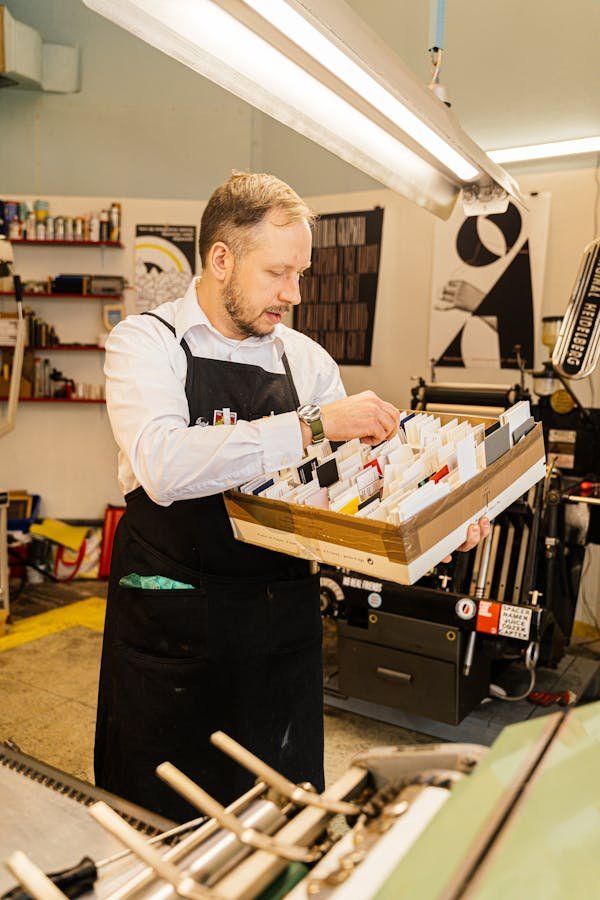|
Getting your Trinity Audio player ready...
|
Why would one start a printing company?
With over $82 billion in yearly sales and supporting tens of thousands of independently owned print shops around the country, the commercial printing sector continues to be the pillar of American small business.
Demand for premium, custom-printed materials—from business cards to promotional swag—continues to rise in an era of digital overload, particularly among small businesses and local companies looking for concrete means to stand out, Entrepreneur.
And, starting from a house garage or small retail space and reinvesting earnings over time designnbuy.com allows a printing venture often to have rather low barriers to entry.
First step: Do market research and define your niche
List Your Target Clients
Choose whether you will serve end consumers (B2C) like event planners or artists, or business clients (B2B), including local realtors, restaurants, and charities. Many print shops survive by combining entrepreneurship.
Examine Local Market Demand and Competition
To find demand in products like business cards, banners, or custom clothing, use local company directories and Google Trends.
Visit surrounding print stores to observe their products, cost range, and degree of customer service. Could you fill in areas including rush orders, environmentally friendly printing, or unusual finishes?
Second step: Create an SEO-friendly business plan
A well-thought-out plan not only directs you but also enables you to draw loans or attract investors.
Financial Forecasts and Startup Costs: Breakdown of Startup Costs
- Printer and press equipment runs $2,000–$20,000 cmsmart.net.
- License and software: $500–$2,000.
- Rent and utilities vary depending on location; $1,000–$3,000/month.
- Marketing and websites range in cost from $1,000 to $5,000.Over three to five years, project conservative, moderate, and aggressive scenarios over metrics.
Choose your business structure and register using legal structures in step three
Choose a structure—sole proprietorship, LLC, S-corp, etc.—that strikes a compromise between tax benefits and liability protection SBA.
licenses and permits
You might call for:
- Registration under Doing Business As (DBA)
- Local business licenses: state and municipal
- Environmental licenses (should one be using solvent-based inks)
- Health & Safety Certificates (OSHA rules).
Fourth Step: control finances and get safe money
Funding Alternatives
- Personal Savings or Credit Cards (not advised due to great interest between $5,000 and $10,000).
- SBA Microloans, up to $50,000 with competitive rates, Bank Loans
Low upfront cost equipment leasing programs
For niche, high-growth ideas, angel investors—also known as crowdfunding—rule.
From day one, use basic accounting tools (QuickBooks, Wave). Cash flow is Create a separate business bank account and credit-card processing merchant services for SBA.
Choose Location and Equipment in Step Five
Home-Based as opposed to Commercial Space
Starting at home keeps overhead low; a store increases visibility and walk-in traffic. Consider: rent, parking, foot traffic, zoning laws, SBA.
Necessary Printing Tools
- Digital Printer/Press (laser or inkjet: $2,000–$10,000 ).
- Kit for screen-printing (for clothing): $250–$1,000.
- Heat Press for vinyl transfers: $150–$500.
- Trimmers, folders, finishing and binding tools.
Software & Technology: Key for scalability and customer convenience, design software either Adobe Creative Cloud or Affinity Designer; web-to- print platforms allow online ordering and custom previews.
Set Up Operations and Workflow: Supplier Relationships – Step 6 Work with trustworthy suppliers of paper, ink, and clothing—evaluate lead times, price, and quality.
Track items and re-order points using basic spreadsheets or a POS system.
Establish checklists for color accuracy, alignment, and finishing to reduce waste and reprints for the entrepreneur’s benefit.
The seventh step is building a strong brand and web presence
Tips for branding: create an unforgettable tagline and logo.
Keep the color scheme of your website, signs, and printed samples constant.
Content Marketing and Social Media
Showcase Facebook and Instagram before-and-after projects.
Here is: Plan regular contests (“Design Your Own T-shirt”) to increase involvement.
The eighth step is starting sales strategies and marketing campaigns
Join your Chamber of Commerce and go to small-business events for local networking.
Give neighboring businesses, schools, and charities promotional discounts.
Online advertising—Google ads aiming at ‘’custom printing.”
Facebook ads with demographic filters and geotargeting.
Promotions and referrals: e.g., business cards plus a flyer package.
Offer 10% off to clients who recommend new business.
Step 9: Establish Great Customer Service Relationships
Give repeat customers free mock-ups and quick turnaround. With orders, send thank-you notes or little branded gifts.
Order Processing and Deliverability
Use well-defined order forms and confirmations.
One could say that for same- or next-day delivery, team up with nearby couriers.
Tenth step: vary and scale your offerings of services
Mugs, pens, tote bags—promotional items—new print services.
Banners, posters, vehicle wraps in large format printing.
Print-on- Demand and Online Shopping – Use sites like Shopify to sell bespoke designs online, Forbes.
Recruiting and Growing
Hire part-time designers or press operators when development calls for it. Think about a small second location or mobile printing van for events.
Advice and Concepts from Leading Business Institutes and Books
Lean Operations: Using just-in-time inventory and Kaizen (continuous improvement) techniques will help to reduce waste.
Eric Ries’s Lean Startup teaches build-measure lessons. Discover: Launch a “minimum viable product” (e.g., a simple online ordering page), quickly get customer comments, and iterate before heavily designnbuy.com invests.
Suggested Books J. Herschel Conklin’s Practical Strategies for Pricing, Margins, and Service Upsells in the Printing Business Amazon.
W. Chan Kim and Renée Mauborgne’s Blue Ocean Strategy identifies uncontested market spaces, such as environmentally friendly printing.
Personal Experience
Like millions of Americans, Brooks Tipton lost his consistent income overnight, working in construction and performing part-time gigs as a musician when the Great Recession struck in late 2008. His rent was due, bills stacked up, and each little concert fee hardly made a difference.
He was uncertain about the future. Still, Brooks saw a chance to redefine himself while many others saw just hopelessness.
Looking for any way to pay the rent, he looked at what bands made money selling and found shockingly rich screen-printed goods, SBA. Brooks spent evenings in his small garage experimenting with inks, adjusting screens, and learning from many mistakes and successes at SVA.
A fellow musician taught him the foundations of silkscreen printing.
With $1,000 saved from odd jobs, Brooks bought his first silkscreen press—a small machine that still created crisp, colorful T-shirts SBA in early 2009.
Every shirt he made for neighborhood gatherings and local brands felt like a minor triumph, inspiring him to believe he could create something enduring from his imagination.
Working from a converted garage space but dreaming of a store-based business, he formally opened Electric Ghost in Little Rock, Arkansas, by September 2009. His first year brought in $99,000 in sales, which motivated him and drew interest from companies, including touring musicians and regional parks.
Growing orders made Brooks realize he needed capital to grow, and that’s when Shannon, his devoted partner and manager of finances, websites, and client relations, stepped in to free Brooks to concentrate on production SBA.
Working with the Arkansas Small Business & Technology Development Center and Forge Community Loan Fund, they obtained a $50,000 SBA microloan, a revolutionary tool that allowed them to relocate downtown, purchase sophisticated equipment, and staff their first employees SVA.
Supported by a team of seven full-time and four part-time employees, servicing everyone from theaters and breweries to schools and military teams overseas, SBA, Electric Ghost thrived over the next decade, revenues rising to almost $585,000 by 2018.
From every milestone—first store, first big contract, first hired designer—Brooks remembered the terror he experienced in that vacant garage and the relentless faith Shannon had in her dream.
Brooks tours as a musician once more today, printing band merchandise on the side, but his most proud contribution is co-founder of a successful small company grounded on grit, passion, and love.
His path reminds us that anyone can use a spark of imagination, unwavering support, and appropriate tools to transform crisis into opportunity.
Questions and Answers
Q. Starting a small printing company calls for what kind of capital?
Calculate all expenses—equipment, facility, licenses—using SBA’s startup cost calculator to estimate funding needs accurately, and take into account leasing, crowdsourcing, or SBA microloans to handle cash flow and future growth planning.
Startup capital usually ranges from $3,000 for a home-based heat-press setup to $30,000+ for commercial digital printers and presses.
Q. With what basic tools should I start?
Along with finishing tools (trimmers, folders) and a computer with design software, you will need core printing equipment—screen-print presses ($2,000–$10,000), digital printers ($10,000–$30,000), heat presses ($150–$500).
Factor in continuous supplies (ink, screens, paper) and consider leasing options to lower upfront investment, including regular maintenance, calibration, and replacement parts to ensure quality and uptime.
Q. How might I find money for my printing business?
Investigate several funding sources: bootstrapped with personal savings, apply for an SBA microloan or bank loan, team with local businesses, or use crowdsourcing.
To wow lenders, ready a lean business plan and financial projections. Remember, using vendor terms and equipment leasing can help SBAs efficiently control cash flow and reduce initial expenses.
Q. How best should I charge for my printing work?
Calculating all direct costs—inclusive of materials (paper, ink), labor, and overhead—and adding a markup matched with market rates will help you set your printing rates; usual profit margins in commercial printing range from 5% to 15–60%.
Review pricing often in relation to competitor benchmarks and make adjustments for demand fluctuations and environmental considerations. Gelato
Q. How might a small printing company be successfully marketed?
Create a multi-channel marketing plan combining local outreach, SEO, and social media; keep a resource blog, highlight portfolio on Instagram and Facebook, and set aside at least 1% of projected income for advertising on your website for keywords like “custom printing. Monthly measure return on investment and modify strategies based on SBSA.
Final Thought and Next Actions
The moment you decide to act sets off your path from concept to a successful printing company. Like Brooks Tipton, you might have financial difficulties, limited budgets, or sharp learning curves, but every obstacle has a seed of possibility.
Equipped with an SEO-friendly strategy, accurate cost projections, and the knowledge to land money, you are ready to carve out your niche in a market ravenous for real, premium print solutions.
Start by stating your vision: specify your niche (business cards, clothing, banners), write your lean business plan, and use SBA’s tools to estimate startup expenses. To get advice and lender introductions, then, network locally—chambers of commerce, small-business conferences, and SCORE mentors.
Make wise investments in basic equipment, strike a balance between cost and quality, and create pricing that meets expenses while yet providing fair value. Never undervalue the influence of branding; a strong logo, a well-run website, and active social media channels will generate referrals and natural traffic.
This is the moment to turn your love of printing into money. Download SBA’s startup cost calculator first, then get in touch with your local Small Business Development Center and start today drawing your business plan. Claim your printing legacy with confidence, imagination, and the relentless belief that your next masterwork is just around the horizon














